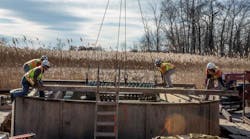Crux Subsurface, Inc. recently provided micropile foundation EPC services within a Priority Wetland for Public Service Electric & Gas Company’s (PSE&G) Susquehanna-Roseland Electric Reliability Project. The specialty deep foundation was selected to accommodate challenging subsurface conditions and access constraints associated with the protected area. The full alignment will span from Berwick, Pa. to Roseland, N.J., with a 1.5-mi segment traversing the Troy Meadows area in Morris County, New Jersey. Micropile foundations were selected for all seven steel pole structures within the wetland due to standing water and other permit access restrictions.
Prime contractor KH&M (a joint venture between Kiewit and Henkles & McCoy) was permitted to mat a roadway to one structure, but the remaining six required helicopter support for materials and equipment. Micropiles are lightweight elements and can be installed using lightweight equipment, making them conducive to these types of restrictions.
In order to minimize impacts to the wetland and facilitate construction activities, a unique closed cell cofferdam was employed at each structure site. This setup provided a stable platform for equipment in soft soils and groundwater, contained drill spoils from entering the wetland, and acted as a form for concrete placement. A rotating drill carriage and micropile drill were set on top of the cofferdam to install micropiles in a battered array. Micropiles proved to be an efficient choice to bridge through extremely soft soils and reach underlying bedrock, which varied in depth between 60 ft to 115 ft below ground level.
Crux completed two rounds of value engineering prior to foundation construction, resulting in a decreased number of micropiles and smaller area of total disturbance for the concrete caps. Reducing the amount of concrete poured and piles installed resulted in significant benefits to a tight project schedule.
The scheduled electrical outage and other environmental restrictions allowed for construction of the six helicopter supported foundations between October 5 and November 23. Crux employed six independent foundation crews to ensure adherence to schedule. Foundation construction was completed ahead of schedule, and all seven tubular steel poles have since been set.


